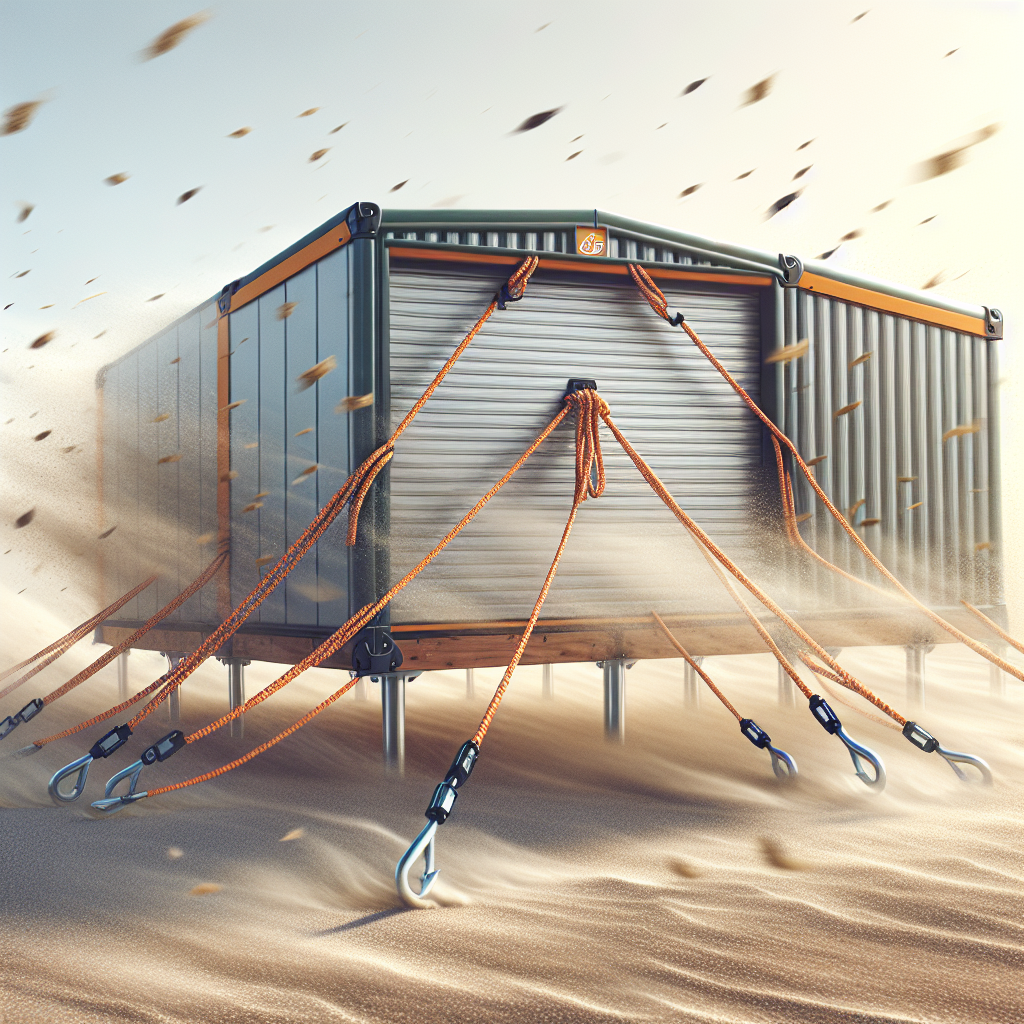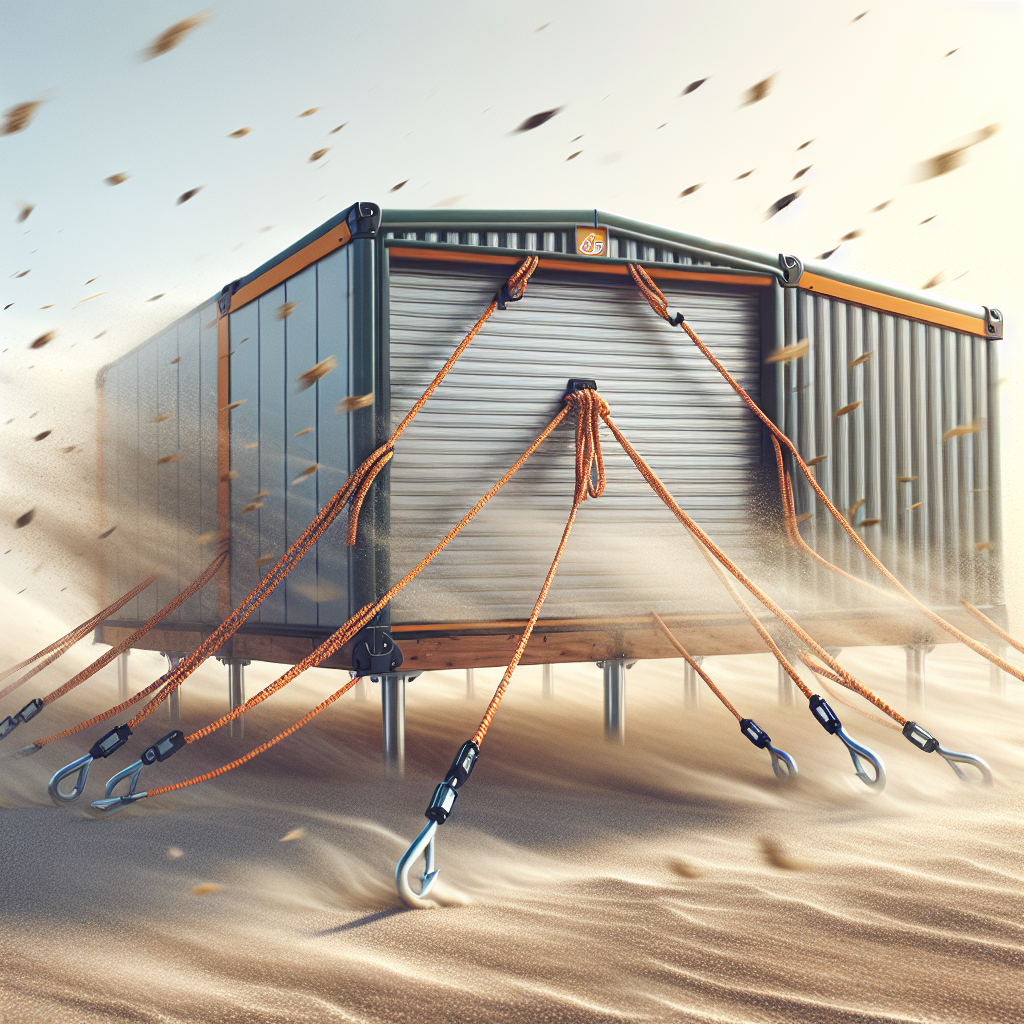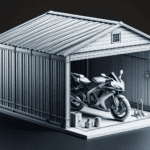Picture this: it’s a breezy day, and you step outside to enjoy the fresh air. As you gaze towards your portable garage, a sudden fear strikes your heart: how can you protect it from the powerful gusts of wind? In this article, we will explore some practical tips and tricks to keep your portable garage sturdy and secure, ensuring it remains in place even amidst the strongest winds. Don’t let the wind dictate the fate of your valuable possessions – let’s find out how you can prevent wind damage to your portable garage.

Choosing a Secure Location
Assessing the Surroundings
When selecting a location for your portable garage, it is essential to assess the surroundings carefully. Look for an area that is sheltered from strong winds, such as being protected by trees or buildings. Ideally, the garage should be placed in a spot with natural windbreaks to minimize the risk of it being blown away.
Considering Wind Patterns
Understanding the wind patterns in your area is crucial in preventing wind damage to your portable garage. Take note of the prevailing wind direction and intensity during different seasons. This information will help you position the garage in a way that maximizes its resistance to strong gusts. Avoid placing the garage in an area where the wind tends to funnel or create turbulence, as this can increase the risk of damage.
Avoiding High-Risk Areas
Certain locations are prone to high winds or extreme weather conditions. It is advisable to avoid setting up your portable garage in such areas to minimize the risk of it blowing away. High-risk areas include open fields, coastal regions, and areas prone to tornadoes or hurricanes. By selecting a more sheltered location, you significantly reduce the chances of wind damage to your garage.
Proper Installation
Anchoring the Garage to the Ground
Properly anchoring your portable garage to the ground is a crucial step in preventing it from blowing away in the wind. Use ground anchors specifically designed for portable garages, as they provide superior stability. These anchors are typically driven into the ground at strategic points around the garage and secured with cables or straps. By properly anchoring the garage, you create a strong connection that helps resist wind forces.
Using Sturdy Materials
When purchasing a portable garage, opt for models made from sturdy and durable materials. Garages constructed from high-quality materials, such as heavy-duty steel frames and reinforced polyethylene covers, offer increased resistance to wind damage. Ensure that all components, including joints, connectors, and fasteners, are made from robust materials to enhance the overall strength and stability of the structure.
Ensuring a Tight Fit
During the installation process, it is essential to ensure a tight fit between the cover and the frame of the portable garage. Any loose or sagging sections can catch the wind and make the structure more prone to damage. Double-check the tension of the cover and make any necessary adjustments to ensure a snug and secure fit. A properly fitted cover reduces the risk of wind getting underneath and causing the garage to lift or collapse.
Regular Maintenance
Inspecting and Fixing Loose Components
Regularly inspect your portable garage for any loose components, such as bolts, screws, or straps. These can weaken the overall structure and make it susceptible to wind damage. Tighten any loose connections promptly, and replace any damaged or missing fasteners. By addressing these issues early on, you can maintain the integrity and stability of your garage.
Replacing Worn-out Parts
Over time, certain parts of your portable garage may become worn out or damaged, compromising its ability to withstand wind forces. Inspect the frame, cover, and other components regularly, and replace any worn-out or damaged parts promptly. By keeping your garage in good condition, you ensure that it remains secure and stable, even in windy conditions.
Maintaining Proper Tension
As with any structure, proper tension is crucial for the stability of your portable garage. Periodically check the tension of the cover and make necessary adjustments to ensure it remains taut. Constant exposure to wind and other weather elements can cause the cover to stretch or sag over time. By maintaining proper tension, you minimize the risk of wind getting underneath and potentially causing damage to the structure.

Preparing in Advance
Monitoring Weather Forecasts
Staying informed about upcoming weather conditions is essential in preventing wind damage to your portable garage. Regularly check weather forecasts and pay attention to any warnings or alerts regarding strong winds. By monitoring the weather in advance, you can take appropriate measures to secure your garage and minimize the risk of damage.
Taking Precautionary Measures
Based on the forecasted weather conditions, take precautionary measures to reinforce your portable garage. If strong winds are expected, consider installing additional anchors or wind braces to enhance the structure’s stability. Taking proactive steps before the winds hit can significantly reduce the risk of damage to your garage.
Removing Potential Projectiles
To prevent wind damage, it is crucial to remove any potential projectiles from the vicinity of your portable garage. Secure loose objects or debris that could become airborne during strong winds. Even small items like garden tools, toys, or patio furniture can pose a risk if they are picked up by the wind and thrown into the garage. By keeping the surrounding area clear, you minimize the chances of your garage being damaged.
Adding Wind-Resistant Features
Installing Wind Braces
Wind braces are additional supports that can be added to your portable garage to increase its resistance to wind forces. These braces typically consist of sturdy metal bars that are installed diagonally across the garage’s frame. When properly installed, wind braces provide additional structural integrity and help prevent the structure from collapsing or blowing away in high winds.
Implementing Ventilation Systems
Proper ventilation is crucial for maintaining the stability of your portable garage during windy conditions. When wind enters the garage, it can create pressure differentials, potentially causing the structure to become unstable. By implementing ventilation systems, such as vents or openings, you can allow airflow to pass through, reducing the risk of pressure buildup and minimizing the effect of strong winds on the garage.
Incorporating Mesh Panels
Mesh panels are a practical addition to your portable garage that can improve its wind resistance while maintaining airflow. These panels are typically made of durable mesh material and can be installed on the sides, back, or front of the garage. By providing a barrier against wind, while still allowing air to circulate, mesh panels help reduce the chances of wind damage to your garage.
Securing Additional Anchors
Using Additional Ground Anchors
In areas prone to strong winds, using additional ground anchors can significantly enhance the stability of your portable garage. Consider installing extra anchors at strategic points around the perimeter of the structure. These additional anchors provide extra support and help distribute wind forces more evenly, reducing the risk of the garage being lifted or moved.
Utilizing Tie-Down Systems
Tie-down systems are an effective way to secure your portable garage and prevent it from being blown away. These systems typically consist of durable straps and ratchet mechanisms that firmly anchor the garage to the ground or nearby structures. Utilize tie-down systems as recommended by the manufacturer, following the instructions provided to ensure proper installation and optimal wind resistance.
Maximizing Anchor Point Connections
The strength of anchor point connections can greatly impact the stability of your portable garage during high winds. Make sure that all anchor points are securely connected to both the garage frame and the ground. Additionally, consider using multiple anchor point connections at each corner or along the sides of the garage. By maximizing the number of anchor point connections, you increase the overall stability and resilience of your garage.
Keeping Garages Clean and Organized
Clearing Surrounding Debris
Maintaining a clean and debris-free environment around your portable garage is essential in preventing wind damage. Regularly clear away any fallen leaves, branches, or other debris that can accumulate near the structure. These objects can potentially become projectiles during high winds and cause damage to your garage. Keeping the surroundings clean minimizes the risk of any objects being blown into the structure.
Keeping Garage Interior Neat
The organization and cleanliness of the interior of your portable garage can also contribute to its stability during strong winds. Make sure to securely store any loose items or tools, avoiding clutter in the garage space. A well-organized interior reduces the chances of objects being picked up by wind and impacting the structure.
Securely Storing Items
When using your portable garage for storage, it is essential to securely store items to prevent them from being tossed around during high winds. Use shelves, racks, or cabinets to keep items secured and reduce the risk of them becoming projectiles. Additionally, consider using bungee cords, straps, or other fasteners to secure larger items that could potentially cause damage if they were to shift during strong winds.
Reinforcing Weak Points
Strengthening Garage Framework
Identify any weak points in the framework of your portable garage and take measures to reinforce them. Reinforcements can include adding extra bracing at critical joints or using corner brackets to enhance stability. By strengthening the framework, you increase the overall robustness of the structure and reduce the risk of wind damage.
Adding Support to Doors and Windows
Doors and windows are potential weak points in a portable garage that may require additional support. Reinforce these areas by adding extra bracing or using impact-resistant materials for doors and windows. Ensure that all openings have secure closures and weather stripping to minimize the risk of wind entering the structure and putting additional stress on the garage.
Repairing Cracks and Gaps
Inspect your portable garage regularly for any cracks or gaps that could compromise its integrity during high winds. These openings can create weak points where wind can enter and cause damage. Promptly repair any cracks using appropriate sealants or patching materials. By addressing these small vulnerabilities, you strengthen the overall structure and improve its resistance to wind forces.
Considering Professional Help
Consulting Experts for Assessments
If you are unsure about the structural integrity of your portable garage or the best measures to prevent wind damage, consider consulting with experts in the field. Professionals experienced in portable garage installation and maintenance can assess your situation and provide valuable insights and recommendations tailored to your specific needs.
Hiring Professional Installation Services
For optimal wind resistance, it may be beneficial to hire professional installation services when setting up your portable garage. Experienced installers have the knowledge and expertise to ensure that the garage is assembled correctly, and all necessary measures are taken to enhance its stability. Professional installation can provide peace of mind, knowing that your garage is securely erected and less prone to wind damage.
Seeking Advice for Upgrades
If you live in an area prone to severe weather conditions or strong winds, it is wise to seek advice from professionals on potential upgrades to your portable garage. They can recommend advanced features or modifications that can enhance the structure’s ability to withstand high winds. By investing in upgrades specifically designed for wind resistance, you can significantly reduce the risk of wind damage to your portable garage.
Educating Yourself on Wind Damage Prevention
Learning About Wind Principles
To effectively prevent wind damage to your portable garage, it is beneficial to familiarize yourself with basic wind principles. Understanding concepts such as wind speed, pressure differentials, and turbulence can help you make informed decisions when selecting a location, installing, and maintaining your garage. Educating yourself about wind principles will empower you to take appropriate measures to protect your portable garage from wind damage.
Understanding Garage Dynamics
Each portable garage model and design may have unique characteristics that affect its stability during windy conditions. Take the time to understand the dynamics of your specific garage, including how wind forces may act upon it. Knowing the vulnerabilities and strengths of your garage allows you to take targeted actions and implement appropriate measures to reinforce its stability.
Staying Informed on Latest Techniques
As technology and research advance, new techniques for preventing wind damage to portable garages may emerge. Stay informed about the latest developments in wind resistance technologies, materials, and installation methods. Industry publications, online resources, and professional advice can help you stay up to date and explore new ways to protect your portable garage from wind damage.
By following these comprehensive guidelines, you can effectively prevent wind damage to your portable garage. Remember that taking proactive steps, such as choosing a secure location, properly installing and maintaining the structure, preparing in advance, adding wind-resistant features, securing additional anchors, keeping the space clean and organized, reinforcing weak points, considering professional help when needed, and educating yourself about wind damage prevention, will significantly increase the stability and durability of your portable garage during windy conditions. With careful planning and attention to detail, your portable garage can withstand the strongest of winds and provide reliable protection for your belongings.







